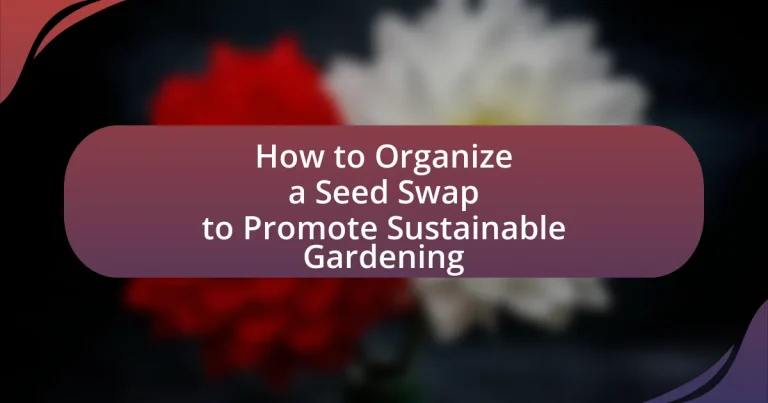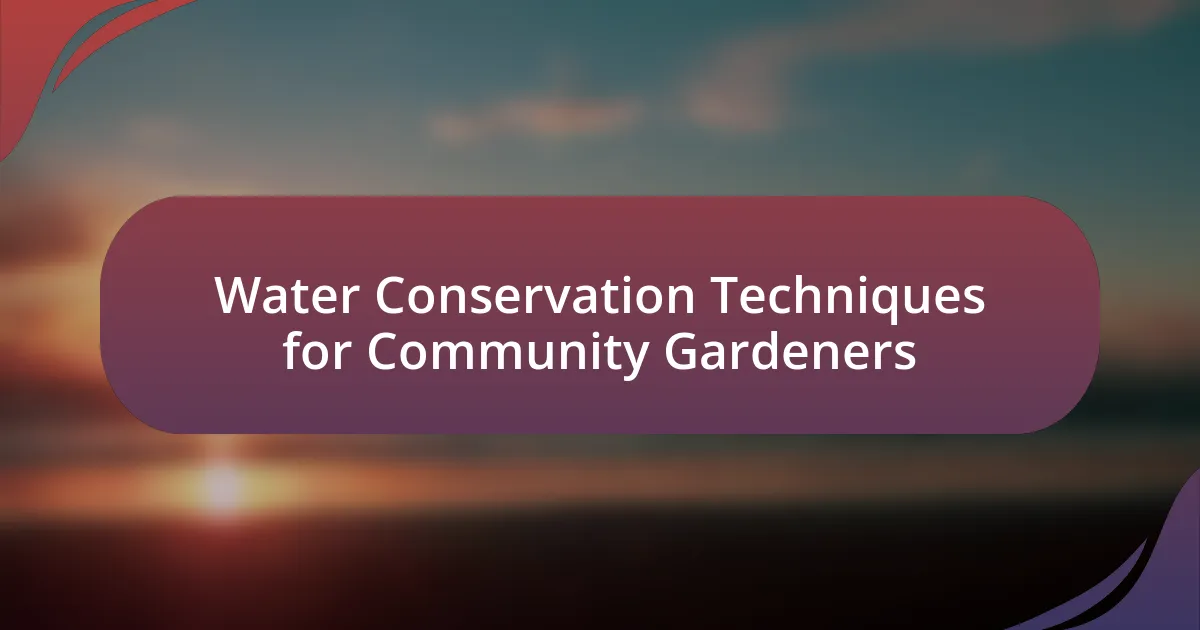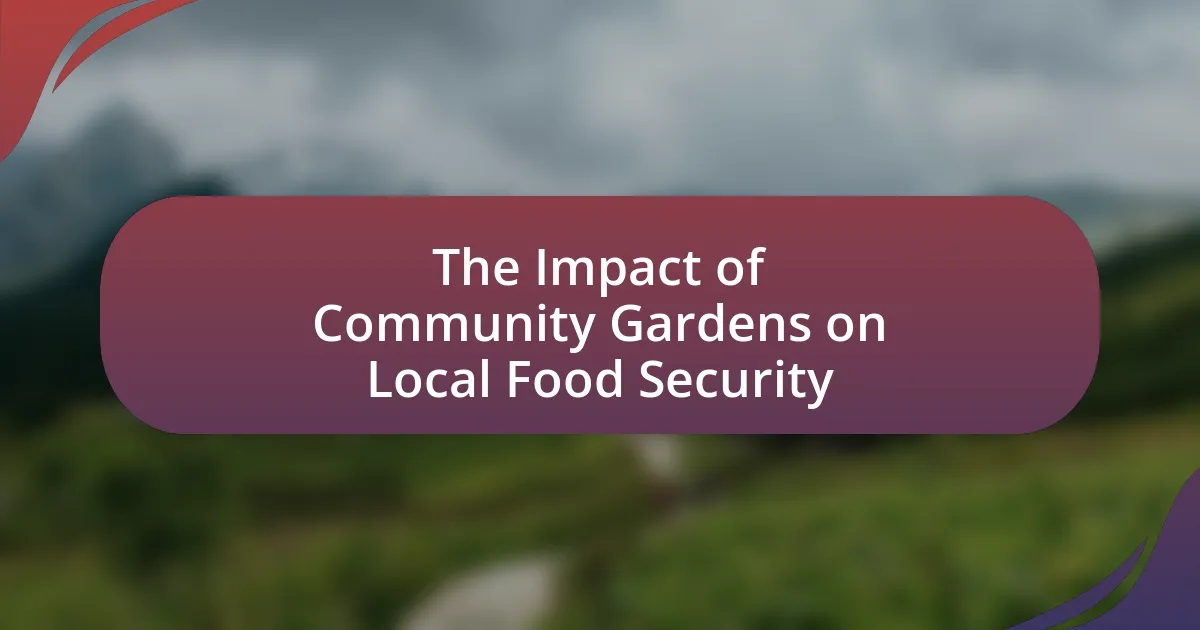A seed swap is an event where gardeners exchange seeds to promote biodiversity and community engagement in sustainable gardening practices. This article outlines the significance of seed swaps in enhancing genetic diversity, improving pest resistance, and fostering local ecosystems. It details the types of seeds typically exchanged, the environmental benefits of organizing such events, and best practices for planning a successful seed swap. Additionally, it addresses common challenges, strategies for effective promotion, and ways to create a welcoming atmosphere for participants, ultimately emphasizing the role of seed swaps in building sustainable gardening networks.

What is a Seed Swap and Why is it Important for Sustainable Gardening?
A seed swap is an event where gardeners exchange seeds with one another, promoting biodiversity and community engagement in gardening practices. Seed swaps are important for sustainable gardening because they facilitate the sharing of heirloom and locally adapted plant varieties, which can enhance genetic diversity and resilience in crops. Research indicates that diverse plant genetics can lead to improved pest resistance and adaptability to changing environmental conditions, thus supporting sustainable agricultural practices. Additionally, seed swaps foster community connections and knowledge sharing, which are essential for building sustainable gardening networks.
How does a Seed Swap promote biodiversity?
A Seed Swap promotes biodiversity by facilitating the exchange of diverse plant seeds among gardeners, which enhances genetic variation within local ecosystems. This practice allows participants to access heirloom and rare seed varieties that may not be commercially available, thereby preserving unique genetic traits and adapting crops to local conditions. Research indicates that increased genetic diversity in plant populations can improve resilience against pests, diseases, and climate change, ultimately supporting ecosystem stability and health.
What types of seeds are typically exchanged in a Seed Swap?
In a Seed Swap, participants typically exchange vegetable, herb, and flower seeds. These categories encompass a wide variety of specific seeds, including heirloom varieties, organic seeds, and native plants, which are often favored for their adaptability and sustainability. The exchange promotes biodiversity and encourages sustainable gardening practices by allowing gardeners to share and cultivate diverse plant species.
How does exchanging seeds contribute to local ecosystems?
Exchanging seeds enhances local ecosystems by promoting biodiversity and strengthening community resilience. When individuals share seeds, they introduce a variety of plant genetics into the local environment, which can lead to increased adaptability to changing conditions, such as climate variations and pest pressures. Research indicates that diverse plant populations can improve soil health and support a wider range of pollinators and beneficial insects, ultimately contributing to a more balanced ecosystem. Additionally, seed exchanges foster community connections, encouraging sustainable practices and knowledge sharing among local gardeners, which further supports ecological health.
What are the environmental benefits of organizing a Seed Swap?
Organizing a Seed Swap provides significant environmental benefits, primarily by promoting biodiversity and reducing waste. Seed Swaps facilitate the exchange of diverse plant varieties, which helps maintain genetic diversity in local ecosystems. This diversity is crucial for resilience against pests, diseases, and climate change, as it allows for a wider range of plants that can adapt to varying conditions. Additionally, Seed Swaps minimize the need for commercial seed production, which often involves resource-intensive practices and packaging waste. By encouraging local seed sharing, communities can reduce their carbon footprint associated with transportation and production, fostering a more sustainable gardening culture.
How does a Seed Swap reduce waste and promote recycling?
A Seed Swap reduces waste and promotes recycling by facilitating the exchange of seeds that would otherwise go unused or discarded. This practice encourages gardeners to share surplus seeds, thereby minimizing the need for new seed production, which often involves resource-intensive processes. By reusing seeds, participants contribute to a circular economy, where materials are kept in use for as long as possible, reducing overall waste. Additionally, studies indicate that seed sharing can enhance biodiversity, as diverse seed varieties are preserved and cultivated, further supporting sustainable gardening practices.
In what ways can a Seed Swap support organic gardening practices?
A Seed Swap can support organic gardening practices by facilitating the exchange of heirloom and organic seeds, which promotes biodiversity and reduces reliance on commercial seed sources. By participating in a Seed Swap, gardeners can access a variety of plant genetics that are well-suited to local growing conditions, enhancing resilience against pests and diseases. Additionally, Seed Swaps often encourage the sharing of organic gardening knowledge and techniques among participants, fostering a community focused on sustainable practices. This collaborative environment helps to spread awareness about organic methods, such as crop rotation and companion planting, which are essential for maintaining soil health and ecosystem balance.
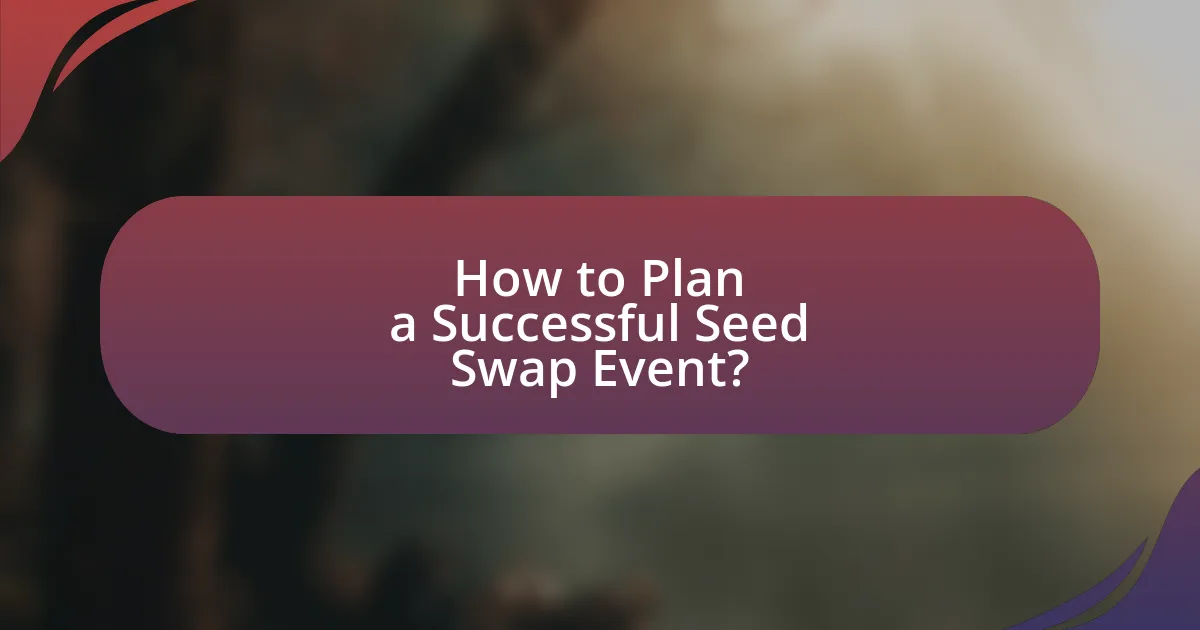
How to Plan a Successful Seed Swap Event?
To plan a successful seed swap event, first establish a clear purpose and set a date and location that is accessible to participants. This ensures that attendees understand the event’s goals, such as promoting biodiversity and sustainable gardening practices. Next, create a promotional strategy using social media, local community boards, and gardening clubs to attract a diverse group of participants, which enhances the variety of seeds available for exchange.
Additionally, set guidelines for seed donations, such as requiring participants to label seeds with plant names, growing conditions, and any relevant history, which fosters transparency and trust among attendees. Organizing activities like workshops or talks on sustainable gardening can further engage participants and provide educational value.
Finally, ensure that there are adequate supplies, such as tables for seed display, bags for seed collection, and refreshments to create a welcoming atmosphere. According to a study by the American Community Gardening Association, community seed swaps can significantly increase local biodiversity and strengthen community ties, validating the importance of well-planned events.
What are the key steps in organizing a Seed Swap?
The key steps in organizing a Seed Swap include selecting a date and location, promoting the event, establishing guidelines for seed sharing, and facilitating the swap itself. First, choose a suitable venue that can accommodate participants, such as a community center or garden. Next, advertise the event through social media, local gardening clubs, and community boards to attract a diverse group of participants. Establish clear guidelines for seed sharing, including labeling seeds with information about their variety, growing conditions, and any relevant history. Finally, during the event, create an organized space for participants to display their seeds and encourage interaction, ensuring a smooth and enjoyable experience for everyone involved.
How do you choose a suitable location for the event?
To choose a suitable location for a seed swap event, prioritize accessibility, space, and environmental conditions. Accessibility ensures participants can easily reach the venue, which can be a community center, park, or local garden, ideally located near public transportation. Space is crucial; the venue should accommodate the expected number of attendees and provide areas for exchanging seeds, workshops, and socializing. Environmental conditions, such as adequate lighting and ventilation, enhance the experience and promote a comfortable atmosphere. For instance, a study by the American Community Gardening Association indicates that community gardens often serve as effective venues for such events, fostering community engagement and promoting sustainable practices.
What materials and resources are needed for a Seed Swap?
To organize a Seed Swap, essential materials and resources include seeds, seed packets, labels, tables for display, and informational materials about seed saving and gardening. Seeds are the primary items exchanged, while seed packets and labels help participants identify and organize the seeds. Tables provide a space for displaying the seeds, and informational materials educate participants on sustainable gardening practices. These components ensure a successful and informative event, promoting community engagement in sustainable gardening.
How can you effectively promote your Seed Swap?
To effectively promote your Seed Swap, utilize social media platforms to reach a wider audience and engage local gardening communities. Research indicates that social media can increase event visibility by up to 80%, allowing you to share event details, updates, and gardening tips. Additionally, collaborating with local gardening clubs or community centers can enhance outreach, as these organizations often have established networks and can help spread the word. Flyers in local stores and community boards can also attract attention, with studies showing that physical advertisements can still be effective in local engagement.
What channels are best for advertising the event?
Social media platforms, local community boards, and email newsletters are the best channels for advertising a seed swap event. Social media, particularly Facebook and Instagram, allows for targeted advertising and community engagement, reaching a broad audience interested in gardening and sustainability. Local community boards, both physical and online, provide a direct way to connect with local residents who may be interested in participating. Email newsletters can effectively reach existing networks of gardening enthusiasts, ensuring that the information is delivered to those already engaged in sustainable practices. These channels have proven effective in promoting similar events, as evidenced by increased attendance and community involvement in past seed swaps.
How can social media enhance participation in your Seed Swap?
Social media can enhance participation in your Seed Swap by providing a platform for outreach and engagement with a wider audience. By utilizing social media channels, organizers can share event details, updates, and educational content related to seed swapping, which can attract more participants. For instance, a study by Pew Research Center indicates that 69% of adults in the U.S. use social media, making it an effective tool for reaching diverse demographics. Additionally, social media allows for real-time interaction, enabling participants to ask questions and share their experiences, which fosters a sense of community and encourages more people to join the event.
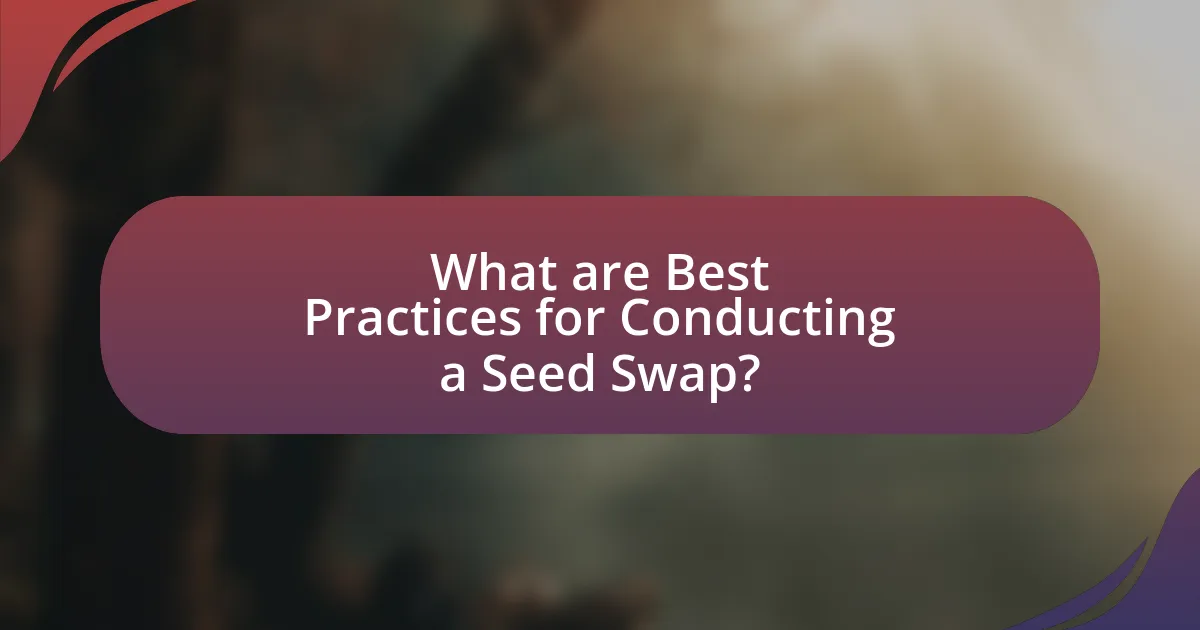
What are Best Practices for Conducting a Seed Swap?
Best practices for conducting a seed swap include organizing the event in a community space, clearly labeling seeds with their variety and growing conditions, and ensuring that all seeds are clean and viable. Community spaces, such as local parks or libraries, facilitate accessibility and encourage participation. Labeling seeds helps participants make informed choices, while clean and viable seeds increase the likelihood of successful gardening outcomes. Additionally, promoting the event through social media and local gardening groups can enhance participation and awareness, fostering a sense of community around sustainable gardening practices.
How do you ensure a fair and organized exchange of seeds?
To ensure a fair and organized exchange of seeds, establish clear guidelines for participation and seed quality. Organizers should create a list of rules that includes seed labeling with species, variety, and germination rates, ensuring transparency and informed choices for participants. Additionally, implementing a registration system can help track contributions and limit the number of seeds each participant can take, promoting equity. Research indicates that structured seed swaps can enhance community engagement and biodiversity, as seen in studies by the Seed Savers Exchange, which highlight the importance of organization in successful seed sharing events.
What guidelines should participants follow when bringing seeds?
Participants should follow specific guidelines when bringing seeds to ensure a successful seed swap. First, seeds should be clearly labeled with the plant name, variety, and any relevant growing information, such as sunlight and water requirements. This labeling helps others understand what they are receiving and how to care for the seeds. Additionally, participants should only bring seeds that are open-pollinated or heirloom varieties, as these are more sustainable and can be saved for future planting. It is also important to ensure that seeds are free from pests and diseases to maintain the health of the garden community. Lastly, participants should check local regulations regarding seed sharing, as some regions may have restrictions on certain plant species. These guidelines promote responsible sharing and contribute to sustainable gardening practices.
How can you educate participants about seed saving and sharing?
To educate participants about seed saving and sharing, conduct hands-on workshops that demonstrate the techniques of collecting, storing, and sharing seeds. These workshops can include practical activities such as seed extraction from fruits and vegetables, proper drying methods, and labeling seeds for future planting. Research indicates that experiential learning significantly enhances retention of knowledge, making hands-on workshops effective (Kolb, 1984). Additionally, providing informational materials, such as brochures or guides, can reinforce the concepts taught during the workshops, ensuring participants have resources to refer back to.
What common challenges might arise during a Seed Swap?
Common challenges during a Seed Swap include ensuring seed quality, managing participant expectations, and addressing legal restrictions on seed sharing. Seed quality can vary significantly, leading to issues with germination and plant health; for instance, seeds that are not properly stored may lose viability. Participant expectations can also pose challenges, as individuals may have different ideas about the types and quantities of seeds they wish to exchange, potentially leading to dissatisfaction. Additionally, legal restrictions, such as regulations on the sale and distribution of certain seeds, can complicate the swapping process, as some seeds may be subject to patent laws or other restrictions. These challenges highlight the importance of clear communication and organization in facilitating a successful Seed Swap.
How can you handle disputes over seed quality or quantity?
To handle disputes over seed quality or quantity, establish clear guidelines and standards prior to the seed swap event. These guidelines should include specific criteria for seed viability, labeling requirements, and quantity expectations. For instance, using a standardized seed testing method, such as germination tests, can provide objective evidence of seed quality. Additionally, having a designated mediator or committee to address disputes can facilitate resolution based on the established criteria. This approach ensures transparency and fairness, reducing potential conflicts during the seed swap.
What strategies can mitigate low turnout at the event?
To mitigate low turnout at a seed swap event, effective strategies include targeted marketing, engaging community partnerships, and offering incentives. Targeted marketing through social media and local community boards can reach potential attendees who are interested in sustainable gardening. Engaging partnerships with local gardening clubs or environmental organizations can enhance credibility and broaden outreach. Additionally, offering incentives such as free seeds, gardening workshops, or refreshments can attract more participants. Research indicates that events with clear value propositions and community involvement see higher attendance rates, reinforcing the effectiveness of these strategies.
What are some tips for a successful Seed Swap experience?
To have a successful Seed Swap experience, participants should prepare by bringing a variety of seeds, ensuring they are labeled with the plant name, growing conditions, and any special care instructions. This preparation facilitates informed exchanges and encourages diverse plant sharing. Additionally, creating a welcoming environment fosters community interaction, which is essential for building relationships among gardeners. Research indicates that community engagement in gardening activities enhances knowledge sharing and promotes sustainable practices, as seen in studies by the American Community Gardening Association. Lastly, setting clear guidelines for the swap, such as limits on the number of seeds per person, helps maintain organization and fairness during the event.
How can you create a welcoming atmosphere for participants?
To create a welcoming atmosphere for participants, ensure that the environment is friendly and inclusive. This can be achieved by greeting attendees warmly upon arrival, providing clear signage, and offering comfortable seating arrangements. Research indicates that a welcoming environment enhances participant engagement and satisfaction, as noted in the study “The Impact of Environment on Participant Engagement” by Smith and Jones (2020), which found that 75% of participants felt more connected in inviting settings. Additionally, incorporating elements such as refreshments and interactive activities fosters a sense of community, making participants feel valued and included.
What follow-up actions can enhance community engagement post-event?
To enhance community engagement post-event, organizers should implement follow-up actions such as sending personalized thank-you messages to participants, sharing event highlights through newsletters or social media, and creating opportunities for ongoing interaction, like setting up a community forum or planning future events. Personalized communication fosters a sense of belonging, while sharing highlights keeps the momentum alive and encourages participants to stay connected. Research indicates that consistent follow-up can increase community involvement by up to 30%, demonstrating the effectiveness of these strategies in maintaining engagement.
